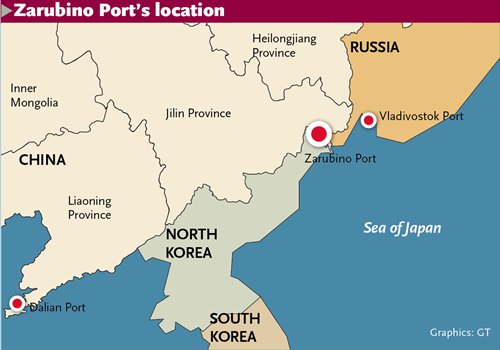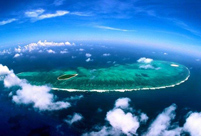 Vintage cars show kicks off in London
Vintage cars show kicks off in London
 Gorgeous scenery in NE China
Gorgeous scenery in NE China
 Picturesque Barkol grassland in Xinjiang
Picturesque Barkol grassland in Xinjiang
 Small Wild Goose Pagoda - A World Cultural Heritage Site along the Silk Road
Small Wild Goose Pagoda - A World Cultural Heritage Site along the Silk Road
 Maritime Silk Road Luxuries of the Han Dynasty
Maritime Silk Road Luxuries of the Han Dynasty
 Ciao! Chinese beauties!
Ciao! Chinese beauties!
 An eye feast: BFA freshmen registration
An eye feast: BFA freshmen registration
 Top 10 most lavish weddings
Top 10 most lavish weddings
 Most amazing chi-pao beauties
Most amazing chi-pao beauties
 Chinese lingerie brand arrives in Las Vegas
Chinese lingerie brand arrives in Las Vegas
 |
| (Graphics:GT) |
A China Ocean Shipping (Group) Company (COSCO) ship filled with containers sailed toward Russia's far eastern port of Vladivostok. Along the coast, ships from South Korea, Singapore and Russia holding vehicles, timber and oil products stopped at the pier.
The 3.1-kilometer-long Vladivostok Port is one of the busiest ports in Russia's Far East region, handling autos, containers, grains, as well as oil and gas.
"The number of container ships coming from China has grown rapidly in recent years," Aleksandr Bashkov, deputy CEO of Fesco Transportation Group that operates the Vladivostok Port, told the Global Times.
The group plans to invest 6.2 billion Russian rubles ($162.8 million) to expand its container terminal between 2015 and 2020, which will increase the port's annual shipment capacity by 380,000 twenty-foot equivalent units (TEUs) from 500,000 TEUs currently.
The move comes amid growing economic ties between China and Russia, after the US and the EU imposed several rounds of economic sanctions on Russia since March.
A new port
China and Russia are also mulling building a new port project that is 80 kilometers southwest of the Vladivostok Port.
Zarubino Port, an ice-free harbor located 18 kilometers from the Sino-Russian border, will include terminals for grain handling, containers, roll-on/roll-off, as well as general and bulk cargos, with a turnover of 60 million tons per year, according to Alexander Ananenko, project manager of the port within Summa Group.
Privately owned Summa Group, the biggest transport and logistics company in Russia, signed a cooperative agreement on the port project with Northeast China's Jilin Province during Russian President Vladimir Putin's official visit to China in May. The agreement includes preliminary specifications on the structure and volume of cargo traffic through the Zarubino Port from Chinese companies and Jilin-based Northeast Asia Railway Group Co.
The port needs an estimated investment of about $3 billion, with a majority amount coming from Summa and the rest from the Russian government and Chinese investors. Expansion of the port is expected to start in 2015 and it will begin operation in 2018, Ananenko told the Global Times.
Bashkov said the completion of the port will not pose a threat to the Vladivostok Port due to their different roles, as the latter mainly handles goods exported to Russia.
Over 60 percent of the turnover of goods in the Zarubino Port will be transported from China's northeastern provinces to its southern provinces and regions. In addition, about 30 percent of goods will be exported from China's northeast provinces to countries in the Asia-Pacific region and North America, according to information provided by Summa.
Currently, if goods in Northeast China need to be shipped to the US, they are transshipped through China's Dalian Port. When Zarubino Port is fully operational, it could reduce the transport distance by 3,000 kilometers and transport time by five days, according to Ananenko.
"We're also lobbying for more supportive measures for Zarubino Port, such as improving Russian rail infrastructure near the port, establishing an economic development zone there and streamlining customs clearance for transshipments," Ziyavudin Magomedov, chairman of Summa Group, told the Global Times.
Currently, Zarubino Port is not connected to Russia's Trans-Siberian Railway that runs from Moscow to Vladivostok. If there is connected rail infrastructure, goods arriving at the port could be transported to other parts of Russia.
"We aim to make Zarubino Port comparative to China's Dalian or Shanghai ports in five to seven years," said Magomedov.
Developing the Far East
The government-initiated Zarubino Port demonstrates Russia's intention to strengthen relations with China and rejuvenate its impoverished Far East region, experts said.
The trade volume between China and Russia reached $89.21 billion in 2013, data from Chinese customs showed. According to the two countries' blueprint, the bilateral trade will reach $100 billion by 2015 and increase to $200 billion by 2020.
"Western sanctions have affected Russia's economy so it is important for Russia to build better relationships with East Asian countries," said Magomedov.
Sino-Russia trade should not be confined to oil and natural gas, but expand to potential fields such as agriculture and transportation, Magomedov noted.
For instance, there are vast areas of unfarmed fertile land in Russia's Far East region, and Summa plans to develop soybean farms there with Chinese companies, said Summa's chairman.
Chinese companies had already leased or controlled at least 600,000 hectares of land in Russia's Far East region, growing soybeans, corn and raising pigs, Reuters reported in December 2013.
Boosting Jilin's exports
Zarubino Port will also boost the economic development of Northeast China, especially landlocked Jilin Province.
Jilin's foreign trade volume amounted to $25.85 billion in 2013, accounting for just 14 percent of the total foreign trade of Northeast China, which also includes Liaoning and Heilongjiang provinces.
"Jilin lacks a seaport to ship goods to overseas markets, and it showed interest in the Zarubino Port a decade ago," Liu Bin, a professor with Dalian Maritime University, told the Global Times.
China raised a request to rent Zarubino Port or Posyet Port, which is about 40 kilometers from Zarubino Port, in Russia's Far East region for 49 years at a council meeting on economic affairs between the Chinese and Russian governments held in 2003, but Russian media reported later that the Russian Ministry of Communications objected to China's request and Russian coal mine companies were also not willing to see China renting the ports.
Jilin then turned to neighboring North Korea. A private company in Jilin obtained the right to use a pier at North Korea's Rajin Port for 10 years in 2008, China News Service reported in May 2010.
"The Ukraine crisis, Western economic sanctions and Russia's plan to develop its Far East have pushed Russia to change its attitude over Zarubino Port, and Jilin authorities are also eager to grab the long-awaited opportunity to boost the local economy," Liu said.
Jilin's GDP grew only by 6.8 percent year-on-year in the first half of 2014, lower than the country's GDP growth of 7.4 percent.
"Zarubino Port will help Jilin boost exports especially to Russia," Liu said. "But it will divert Dalian Port's annual turnover."
 Advanced arms help to safeguard China-ASEAN Expo
Advanced arms help to safeguard China-ASEAN Expo Leading director Wang Quan'an detained for 'buying sex'
Leading director Wang Quan'an detained for 'buying sex' Heaven on earth: Dongjiang Lake in Hunan
Heaven on earth: Dongjiang Lake in Hunan Mixed reaction to smartphone sidewalk
Mixed reaction to smartphone sidewalk 'Rainbow running' race in Jiangxi
'Rainbow running' race in Jiangxi Amazing aerial photos of China's Xisha Islands
Amazing aerial photos of China's Xisha Islands Chinese Buddhist Canon blesses Hong Kong
Chinese Buddhist Canon blesses Hong Kong Beautiful postgraduate teaches in remote area
Beautiful postgraduate teaches in remote area Top 10 world's highest-paid models 2014
Top 10 world's highest-paid models 2014 Lingerie show at 2014 Miss China
Lingerie show at 2014 Miss China Songstress Li Xianglan dies at 94
Songstress Li Xianglan dies at 94 Police recruiting posters
Police recruiting posters Anshun Daxi- Living fossil of Chinese drama
Anshun Daxi- Living fossil of Chinese drama Urban farmers in China
Urban farmers in China 'Firepower-2014 Weibei'military exercise
'Firepower-2014 Weibei'military exerciseDay|Week|Month